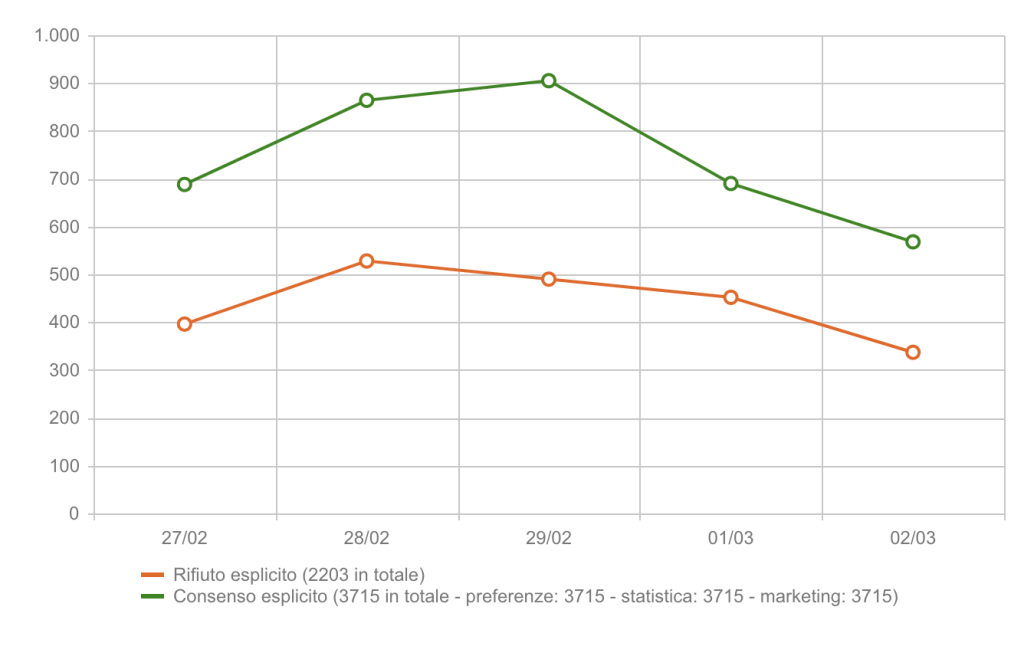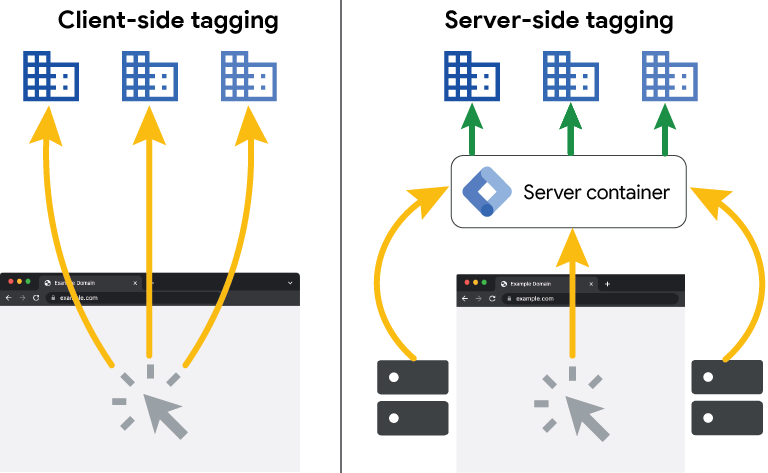The Importance of Server-Side Tracking in Online Data Analysis

In the digital age, tracking online activities plays a crucial role for businesses looking to better understand their users’ behavior and optimize their marketing strategies. Among the various tracking methodologies available, server-side tracking emerges as an essential practice to ensure accurate data, security, and regulatory compliance. In this article, we will explore the importance of server-side tracking and the advantages it offers to businesses.
What is client-side tracking
Client-side tracking relies on the use of scripts or tracking codes that are executed directly in the user’s browser.
Typically through lines of JavaScript code, data is sent directly to a measurement server (such as Google Analytics, Matomo, or Adobe Analytics) or advertising server (Google Ads, Facebook Ads, TikTok ads) when the user interacts with our website or app.
This data collection on platforms leverages cookies, text files that refer to the platform that generated them and are intended to track user behavior.
Limitations of client-side tracking
Client-side tracking relies on the use of cookies on users’ computers.
Systems have long since moved towards a cookieless world. Intelligent Tracking Prevention (ITP) is a technology implemented by major web browsers, such as Apple’s Safari and Mozilla’s Firefox, to protect user privacy by limiting data tracking by websites and third parties.
ITP uses various techniques to reduce tracking, including blocking third-party tracking cookies and limiting the duration of first-party cookies used for tracking. Additionally, ITP analyzes user behavior and blocks any tracking attempts through techniques such as fingerprinting.
The main goal of ITP is to provide users with greater control over their online privacy, while also reducing the ability of websites and third parties to collect tracking data without consent. However, this can also affect web analytics and online marketing practices, as it limits access to data used to track user behavior and measure the effectiveness of advertising campaigns.
Google, on the other hand, continues with the implementation of its Privacy Sandbox. At the beginning of January, it began blocking cookies and plans to eliminate the use of third-party cookies for all users in the second half of 2024.
Data with denied cookies
The ability for users to deny consent for data collection (by clicking on “accept only necessary cookies,” for example), particularly rejecting advertising cookies, has significant consequences for web analytics.
With the correct implementation of a CMP platform to comply with GDPR and cookie legislation, there is a decrease in the data collected on platforms such as Google Analytics, Google Ads, Microsoft Bing Ads, and others.
The lost data depends heavily on sectors; the following is the consent chart of a small-medium-sized e-commerce site in Italy that operates in both B2C and B2B, where the refusal to consent to cookies is around 40%.

Taking an overview of various merchandise sectors on CMP platforms, it is observed that the refusal to provide consent ranges from 30% to 60% of lost data. Through correct and targeted cookie attribution (which often is not done), it is possible to stay in the lower range (around 30/40%), but without optimization, it is easy to reach up to 60% of refusals.
Machine Learning and prediction systems of analytics platforms, besides not providing accurate data, do not allow filling the gap of detected data.
Let’s take GA4 (Google Analytics 4) as an example, but the same applies to all available web analytics platforms.
The GA4 platform utilizes several methods to compensate for the lack of data and provide reliable estimates on user visits even when available data is limited. Among the main approaches used:
- Utilization of available data: Even if the data may be limited, GA4 still uses the available information to identify patterns and trends in user behavior. This data is then used to make estimates on user visits.
- Predictive models: GA4 employs predictive models based on machine learning to forecast user behavior. These models consider a range of factors, such as past user behavior, demographic characteristics, and browsing data, to estimate the number of user visits.
- Compensation for missing data: When data is limited, GA4 can compensate for this lack using techniques like interpolation of existing data or filling in gaps with estimates based on statistical models. Although these estimates may not be entirely accurate, they still provide a useful indication of user behavior.
- Trend monitoring: GA4 continuously monitors trends in user behavior and updates its predictive models based on new available data. This helps ensure that the provided estimates are as accurate as possible, even when data is limited.
In summary, while aware of the limited amount of available data, GA4 uses a combination of predictive models and compensation techniques to provide reliable estimates on user visits and other analysis data, enabling businesses to make informed decisions based on available data.
When the data loss resulting from cookie rejection is lower (around 40%), the platform tries to integrate and provide a visualization as close to reality as possible, but it will always be the result of compensation and prediction. The data may be increased but will never be very close to reality.
The creation of audiences for the advertising part becomes increasingly random, with advertising spending directed towards a non-target audience, resulting in increased costs and decreased conversions.
What is Server-Side Tracking?
Server-side tracking refers to the practice of sending tracking data directly from the web server to the data analysis system, bypassing the user’s browser. Unlike client-side tracking, which occurs in the user’s browser through JavaScript scripts, server-side tracking occurs on the server side, where HTTP requests are processed.
Advantages of Server-Side Tracking:
Data Accuracy: Server-side tracking offers greater data accuracy compared to client-side tracking. Since data is processed directly on the server, it is less likely to be influenced by browser extensions, ad blockers, or other changes made by the user.
Data Security: By transmitting tracking data directly from the server, server-side tracking reduces the risk of exposing sensitive user data. This approach provides greater control over data management and helps mitigate privacy and security risks.
Regulatory Compliance: With the increase in privacy regulations such as GDPR in Europe and CCPA in California, companies must take measures to ensure regulatory compliance. Server-side tracking allows companies to more effectively manage user consent and comply with data privacy regulations.
Flexibility and Scalability: Server-side tracking offers greater flexibility and scalability than client-side tracking. Companies can customize their tracking implementations based on their needs and easily integrate new data analysis tools and features.
Better Resource Management: By transferring the tracking workload from the user’s browser to the server, server-side tracking allows for more efficient resource utilization and better management of website traffic.
All of this results in:
– Reduced page loading time
– Prevention of tracking by ad blockers. In Italy, 27% use such tools; for a complete list for each country, the backlinko list can be consulted.

Implementing Server-Side Tracking
In summary, server-side tracking represents an important and necessary tool for companies that want to obtain accurate data, ensure data security, and comply with privacy regulations. In addition to being able to collect data for building audiences in the case of online advertising activities.
By using server-side tracking, companies can gain a more accurate and truthful understanding of online user behavior and make informed decisions to optimize their marketing strategies and improve website performance.
Google Marketing Platform Certification
The GMP (Google Marketing Platform) certification is a program offered by Google that allows digital communication companies to demonstrate their expertise in using various platforms and marketing tools offered by Google. This certification confirms that agency professionals have acquired knowledge and skills in effectively using platforms such as Google Analytics, Google Tag Manager, Google Data Studio, and other online analysis and advertising tools offered by Google. Certification is obtained by passing an official online exam provided by Google.
Only a few Italian agencies, which can be counted on one hand, have this certification: we are among them, an official recognition of how we can help companies address the challenge of data consistency and server-side data.
What to Use for Server-Side Tracking
This is part of our consultancy 🙂 We can discuss and provide you with the best solution to optimize your data and costs, as well as improve the conversions of your advertising activities.
Continua a leggere
And it consumes less energy.
To return to the page you were visiting, simply click or scroll.


